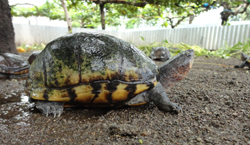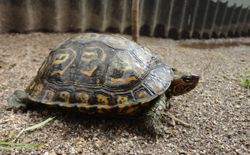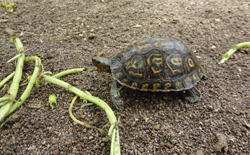Kinosternon scorpioides Care
Common name: Scorpion Mud Turtle
Synonyms and Other Names: chachagua, tortuga de pecho quebrado, pecho quebrado

One of the larger Genera in terms of the number of species is Kinosternon – the Mud turtles. Mud turtles can be found from the Canadian Southern border to central South America. These species are more carnivorous than most turtles with a natural diet that relies heavily on fish, snails, crustaceans and insects. While some species of mud turtles can attain a size of 22 cm. (9 inches), the much more commonly seen Kinosternon subrubrum only attains 12 cm (5 inches) maximum.
Present knowledge and technology make Mud turtles easily maintained animals as long as a person is willing to provide some basic requirements. Thanks to the success that breeders are having with these species it is now possible to purchase many of these species as hatchlings from captive born stock. Many of the species are threatened or endangered in nature; do not remove these animals from the wild.
HOUSING MUD TURTLES INDOORS
The most useful form of indoor accommodation for Kinosternon consists of an aquarium. Mud turtles do a great deal of “bottom walking”, because of this I suggest using shallow water to allow them to easily reach the surface to breathe. For hatchlings I would suggest a water depth of 2 to 4 inches (5 to 10 cm) with one end built up with rocks to provide a dry basking spot. It is possible that they will seldom use this. Mud turtles do very little basking but the addition of a shelf just below the surface of the water gives them another option to bask – in this case without leaving the water. A reasonable size aquarium for a hatchling is a 20 gallon: 30 inches by 12 inches, (75 cm by 30 cm). As the animal grows the size of this habitat should be increased. Water depth is not as critical as they get older but again, it should be remembered that they spend most of their time on the bottom so exceptional depth may stress them. A depth between 8 inches and 12 inches (20 cm to 30 cm) would be fine for adult turtles, which are between 4 inches (10 cm) and 9 inches (22 cm) , depending on the species. In addition a hiding place or cave under the surface of the water is something that will be readily used and lower stress. Make certain if this is made out of rockwork that it cannot collapse on the turtle. I find that half of a flowerpot works well for this purpose.

Water quality is very important. Many problems with aquatic turtles can be averted if one spends a little time and money designing and purchasing an adequate filtration system for your pets. For adult Mud turtles we advise canister filters as they are easily cleaned and provide for excellent water quality. Hatchlings are more difficult to provide good filtration for because of the depth of the water, for these a submersible foam filter or power filter and frequent water changes is the rule.
While Mud turtles have been successfully reared without providing basking facilities I feel that the addition does not hurt them in any way and, in fact, may help to promote more natural day / night activity. Also if live plants are used lighting is , of course, necessary. In one corner of the environment a hardware store reflector clip light lamp should be positioned over a dry basking area and the slightly submerged shelf to provide artificial basking facilities. This should be positioned to provide a basking spot of 90 degrees F or so (32 degrees C) in that section of the habitat. The habitat may also be equipped with a full spectrum fluorescent light to provide for UVB. A UVB source is necessary for Vitamin D3 syntheses (needed in calcium metabolism). If preferred to this lighting arrangement a Mercury vapor bulb may be used that fulfills all requirements though the expense of this would possibly be better spent on a better filter apparatus with this species. Live or plastic aquatic plants are suggested to provide a sense of security and hiding places.
OUTDOOR HOUSING
Predator proof outdoor habitats offer many advantages over indoor accommodations and should seriously be considered as an option during warm weather. A child’s wading pool sunk into the ground in a secure enclosure makes for a serviceable outdoor habitat. Larger ponds with advanced filtration can be used to provide a spectacular outdoor home for your Mud turtle.

DIET:
Be careful not to overfeed your Kinosternon. I recommend only feeding 2 to 3 times a week for adult turtles and every day or every other day for the rapidly growing hatchlings. Mud turtles are highly carnivorous: crayfish, snails, insects and worms may make up a large part of their diet. Some vegetable matter such as duckweed is also taken. Many of the commercially prepared turtle diets that exist on the market today are excellent Mud turtle food. As most prepared foods float it may take a while for the turtle to recognize these as food because they forage on the bottom. Allow the food to sink and remain on the bottom for a time prior to cleaning because of this foraging adaptation.
Additional calcium supplementation is essential. Powdered calcium can be sprinkled all foods. It is suggested that you can use calcium supplemented with vitamin D3 if the animal is being maintained indoors and calcium without D3 if it is outdoors. Provision of a cuttlefish bone, which can be gnawed if desired, is also recommended. Addition of multivitamins if a commercially prepared turtle diet and/or live fish are NOT used is essential for proper fat metabolism. The freezing process for fish destroys the vitamin E which is an important component for maintaining a healthy Mud turtle.
Some of these species hibernate in nature. After careful research of methods used to safely do this, hibernation facilities may be provided for those that do so.